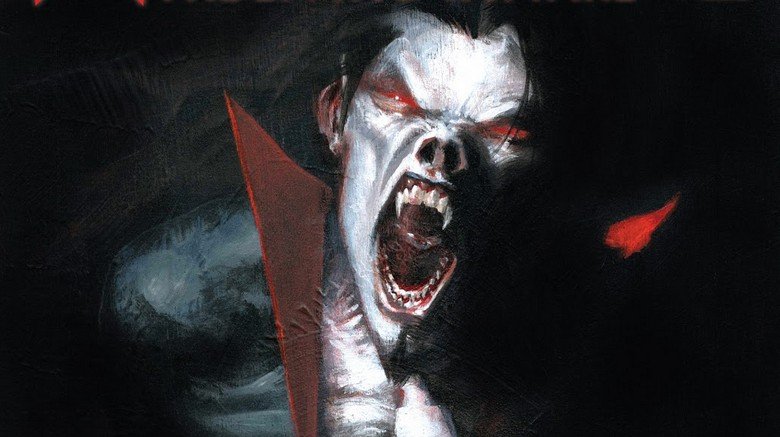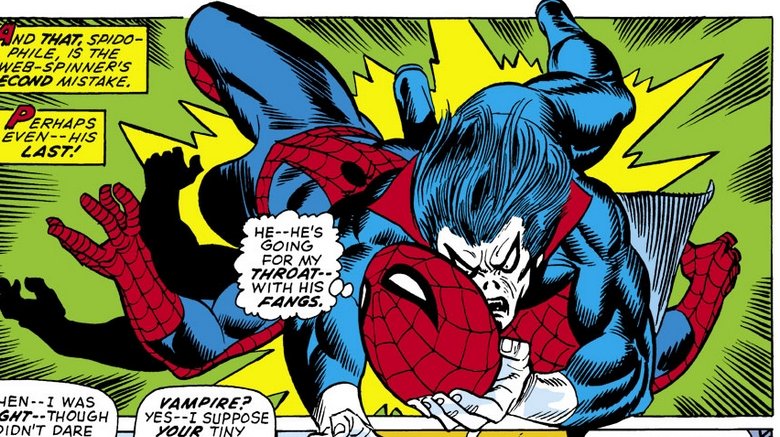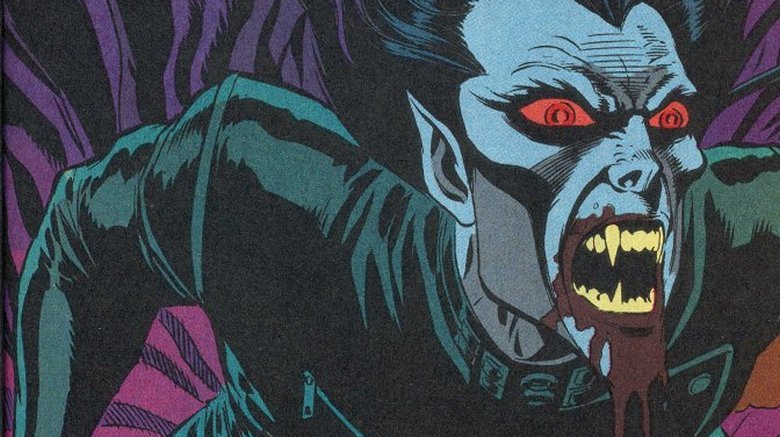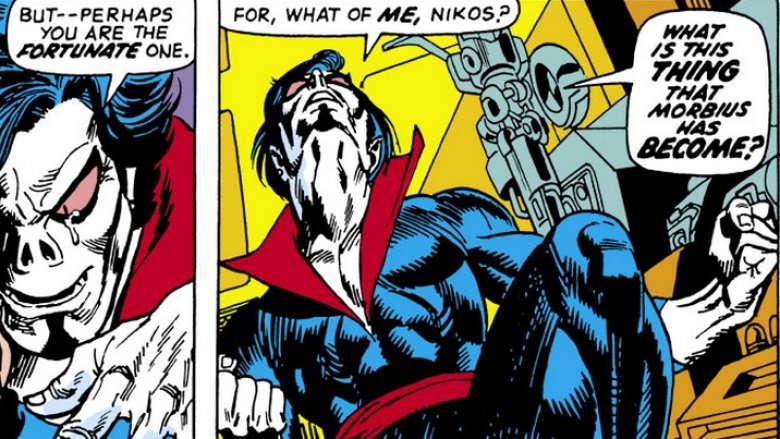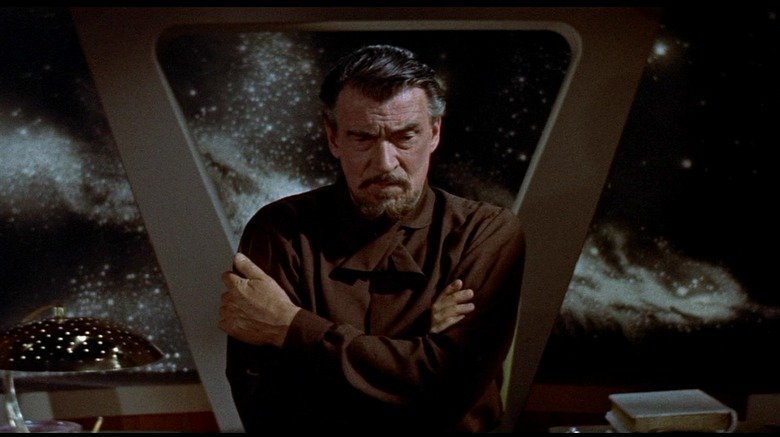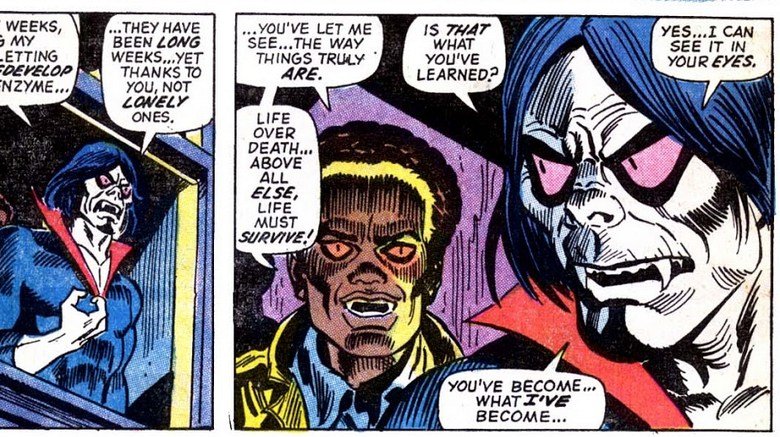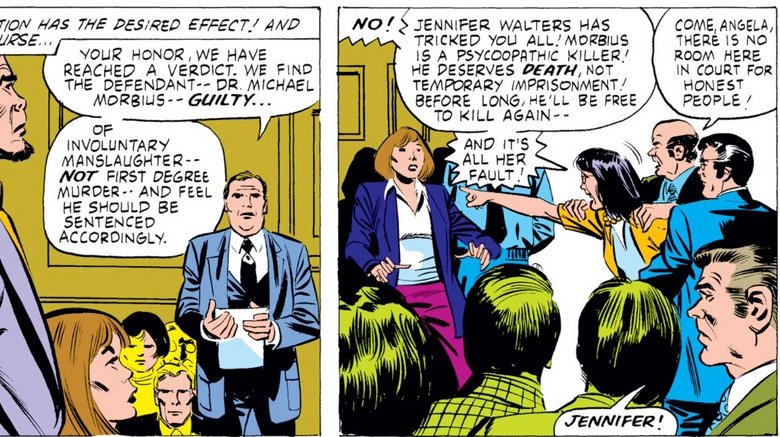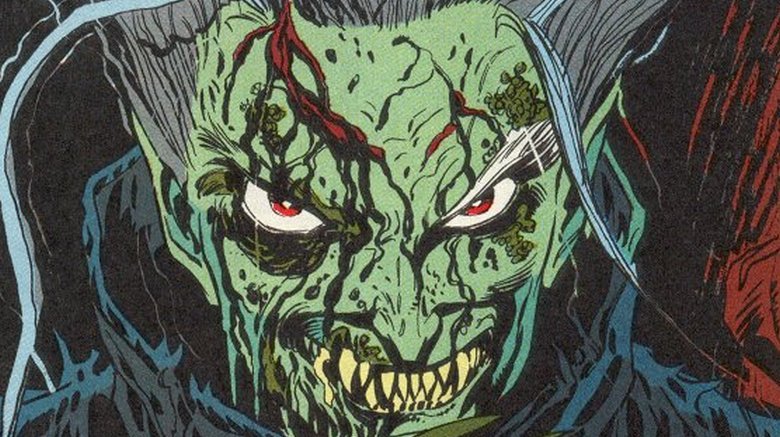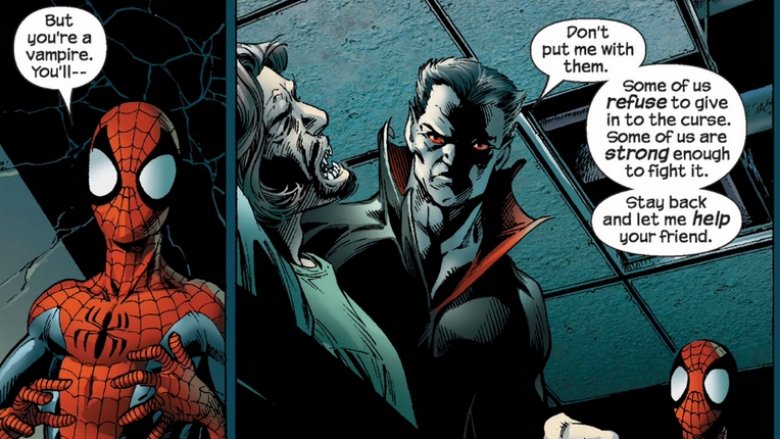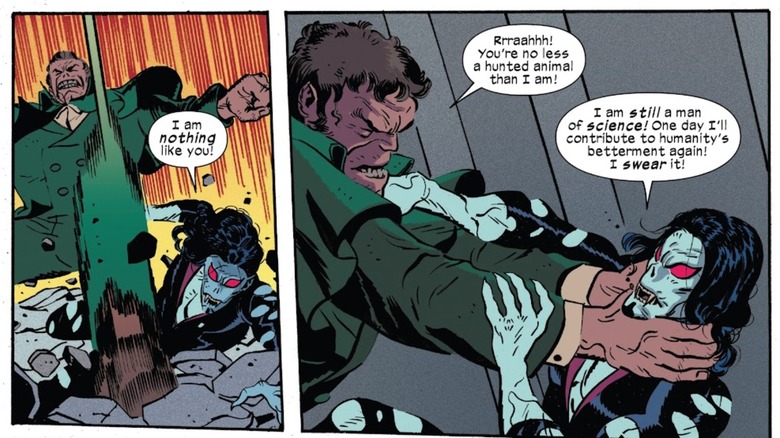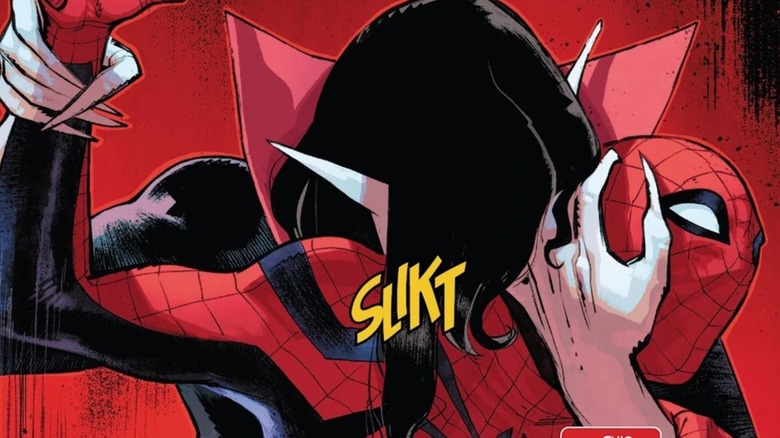The Untold Truth Of Morbius The Living Vampire
Since the announcement that Jared Leto was going to be jump into Sony's small Marvel pond as the vampire Morbius, fans have been asking what was likely the same thing Leto asked: who the hell is Morbius?
Morbius is a vampire whose curse comes more from the test tube than the netherworld. He brought his condition unwittingly upon himself while trying to cure his rare blood condition. He's sometimes a villain, sometimes a hero, and often — as Star-Lord might say — a bit of both. He premiered in 1971's Amazing Spider-Man #101 as a bad guy. Eventually, he was more unstable ally than villain. He headlined for a while in Marvel's horror comic Fear, landed his first shot at a solo monthly book with Morbius: The Living Vampire in 1992, and another in 2013 with the same name.
A constant throughout Morbius' history is that he's a tormented soul seeking salvation. That's not exactly a rare formula for a vampire hero, but when you consider he began his super-guy life in the early '70s — when almost no super-heroes were drinking their victims' blood, not even the Teen Titans (yet) — you might start to see how the chalk-skinned killer remained memorable enough to endure the decades without as mighty a fan base as that of Wolverine or Batman.
Here's the untold truth of Morbius, the Living Vampire.
Morbius the Sinister
Morbius often walks the line between good and naughty. If you're getting mugged and he happens by, sure, he'll probably step in and help (but he's likely to get a snack at the same time). But when he first showed up in 1971's Amazing Spider-Man #101? He was tragic and he was tormented, but there was no anti-hero nonsense going on. Morbius was a killer.
Amazing Spider-Man #101 was memorable for a few reasons; most notably, it was the first issue of the comic that wasn't written by Stan Lee. Roy Thomas took over writing duties, and Lee had left Thomas with a bit of a dangler: Peter Parker had six arms. Spider-Man sought out the Nobel-prize winning Dr. Morbius in hopes that he could find a cure in the doctor's research. Instead, he found a bloodsucking vampire who looked like he'd been dipped in flour right after he raided The Bee Gees' wardrobe.
Thomas and Gerry Conway, who wrote Morbius' subsequent appearances in Marvel Team-Up, spoke to Back Issue in 2009. Both said they never imagined Morbius would go on to become a dark hero. Conway said, "I more or less thought of him as a one-shot villain."
They both agree, though, that the foundation for something more was there in Morbius' first appearance. "Both sides of him were always there," Thomas said. "He was always supposed to be a fairly sympathetic character."
Morbius vs the Code
Some fans believe that Morbius was rendered a "living" vampire as a sneaky way of getting around the Comics Code, and that his subsequent popularity helped force changes to the Code. The Comics Code was a self-imposed industry standard that — among other things — banned representations of the undead. Morbius' "living" status was Marvel's loophole, or so the erroneous legend told.
The truth is that Morbius' creation was a response to the Comics Code loosening its rules about vampires, zombies, and other undead creatures. Talking to Back Issue, Roy Thomas said Stan Lee wanted to capitalize on the Code's less restrictive view toward vampires. Thomas said he and Lee first discussed using Dracula as the villain in Amazing Spider-Man #101, "but Stan wanted a costumed villain." Since Dracula almost never raided the Bee Gees' wardrobe, Morbius was born.
Ironically, while his creation didn't create any friction with the Comics Code, years later another Morbius artist claimed to have locked horns with the Code over his work on the character. Penciler Ron Wagner worked on the first fourteen issues of Morbius: The Living Vampire, and in 1993 he told Wizard he got in trouble with the Code for sexually explicit drawings in the comic.
Operative word: living
While Morbius' "living" status was not a sneaky way around the Comics Code, it was an important aspect of his character if, for no other reason than the fact that it allowed him to remain in the Marvel Universe for longer than his undead contemporaries.
In 1983's Doctor Strange #62, the Sorcerer Supreme famously used his magic to boost the Montessi Formula, killing Marvel's Dracula and the rest of the world's vampires. Eventually, Dracula would come back in the series Nightstalkers, but it would take a decade for the godfather of all vampires to make his way back to the world, and in the meantime one vampire remained completely unaffected by any of it: Morbius.
Because Morbius' condition had nothing to do with being bitten by some seductive undead temptress, imbibing the blood of the damned, or eating wings after midnight, Doctor Strange's war on Dracula had no impact on Doctor Morbius. Other than, you know, he probably had a lot more food available considering all the competition was dust.
Plan Morbius from Outer Space
According to Roy Thomas — who co-created Morbius with Gil Kane in Amazing Spider-Man #101 — the conception of the Living Vampire involved a marriage of different campy science-fiction references, though not all of them were intentional.
Morbius' name, Thomas admitted to Back Issue, came from the character Dr. Edward Morbius from the 1956 film Forbidden Planet. Thomas told the magazine it wasn't a conscious choice, however, and he didn't realize that's where he had lifted the name from until after the comic was already on spinner racks.
He also told Back Issue that the inspiration for Morbius being a creature of science fiction rather than fantasy came from a film he had seen in his youth when radiation, instead of magic, turned a character into a vampire. But apparently he couldn't remember the name.
While neither film fits exactly with Thomas' memory, two films released in 1957, just a year after Forbidden Planet, could fit the bill of science-created vampires. Not of This Earth features an alien who disguises himself as human and drains victims of their blood. The same year saw the release of The Vampire, about a man who unwittingly contracts vampirism after ingesting pills made of vampire bat blood.
To Infect, or not to infect
One of the least-defined aspects of Morbius' condition is why he sometimes infects victims with vampirism and other times doesn't. When he does change his victims, the nature of those transformations aren't consistent.
Morbius killed plenty of people, particularly earlier in his comic book career. The first character he ever transformed into a vampire was Jefferson Bolt in Marvel Team-Up #3. Bolt retained his free will and intelligence, eventually turning on Morbius. In a more recent example, in the one-shot Legion of Monsters: Morbius, the vampire transformed a dying drug addict into a vampire and almost immediately had to kill her when she went wild. He even once turned his old rival Blade into more of a vampire in an issue of Peter Parker: Spider-Man.
But more often than not, Morbius' victims either die or survive with injuries. Whether or not his abilities allow him to infect others seems to depend on what's convenient for the story.
A little help from my She-Hulk
One of the most important stories in Morbius' history — because it allowed the character to transform from a tragic villain to a dark hero – involved a weird, violent court scene in the pages of Savage She-Hulk.
Temporarily cured of his pseudo-vampire condition, Dr. Morbius was working on ways to help lawyer Jennifer Walters, better known as She-Hulk. While helping Walters, Morbius was recognized and arrested. Walters defended Morbius during the trial and used a bizarre method to protect her client; a method which would've gotten her in trouble with lots of animal rights groups were she to try it today. To prove Morbius was not in control of his actions while he was a vampire, Walters brought a pair of rabbits into the court and fed one of them the formula that had transformed him. Predictably, the rabbit immediately went full Holy Grail and killed its furry mate.
Walters succeeded in getting Morbius' charges reduced, but the public wasn't happy with her. Right after the jury read its decision, her father told her he was ashamed of her and would have nothing more to do with her.
Story vs gory
When Morbius got his first shot at a solo title with Morbius: The Living Vampire in 1992, it began with the writer/artist team of Len Kaminski and Ron Wagner. In spite of the passion Kaminski felt for the project, his time on the title was short-lived. The reason? Apparently he wrote too much story.
Speaking to Back Issue in 2009, Kaminski described Morbius as one of his dream projects. "My subtle plan was to break in big on an established series," Kaminski said, "... and once I was sufficiently established talk some hapless editor into letting me do Morbius." He said he'd plotted Morbius to its 50th issue and had an unrealized Morbius/Spider-Man/Venom crossover in the works.
But Marvel Editor Bobbie Chase fired Kaminski, and his last issue as writer was Morbius: The Living Vampire #8. Kaminski told Back Issue he wasn't sure why Chase fired him, but in a 1993 Wizard article, Ron Wagner said he was tired of Kaminski's character-driven stories, that he wanted more action and more gore, and that Chase agreed. When Wizard reached out to Kaminski for comment, the writer said Wagner used to leave snide notes in the margins of Kaminski's scripts. Kaminski said he called Wagner several times to discuss the artist's criticisms, but Wagner never answered and never responded to messages. Once Chase fired Kaminski, Morbius colorist Gregory Wright gave Wagner the gorier scripts he wanted. Regardless, Wagner was gone from the book after the 14th issue.
Ultimate Morbius
The Morbius of the Ultimate comics was introduced in Ultimate Spider-Man #95. The Ultimate version of Morbius was more connected to the vampires of his world than his Marvel Earth-prime counterpart — a more traditional, undead vampire who told Spider-Man he was the son of Dracula. Ironically, though more attached to the world of the undead than the original, the Ultimate Morbius was not only not a villain, but spent his time hunting his brethren.
While Marvel officially nailed the coffin on its Ultimate line of comics in 2015 with the Secret Wars tie-in miniseries Ultimate End, the Ultimate line's impact on Marvel's film adaptations can't be ignored. A lot of what we've seen in the MCU was first seen in the Ultimate Comics. Nick Fury was first drawn as Samuel L. Jackson in Ultimates six years before the actor appeared as the S.H.I.E.L.D. Director in Iron Man. Black Widow and Hawkeye being a part of the original Avengers line-up, Bruce Banner becoming the Hulk while trying to rediscover Captain America's Super Soldier formula, Captain America's World War II era outfit, and even the Chitauri all started in the Ultimate comics. There's no reason to believe the Morbius filmmakers wouldn't learn from the MCU's example and pull from the Ultimate version of the character.
The Blade villain who almost was
Not only did Morbius almost star in a film adaptation before Jared Leto took the roler, if David Goyer's plan had been realized, the Living Vampire's first big-screen appearance would likely have pre-dated the MCU by a half-decade at least.
On a deleted scene found on the DVD of 1998's Blade, a mysterious figure in a dark trench coat watches from a nearby rooftop as Blade and Karen emerge triumphant from their conflict with La Magra. Blade writer David Goyer confirmed the figure was Morbius and, had Goyer gone on to direct Blade II, Morbius would have been the villain for the sequel. Instead Guillermo del Toro directed Blade II and the story was altered, jettisoning him.
It would be interesting to sidestep into an alternate reality where Goyer got to write his version of Blade II. Morbius was full of potential, particularly if Goyer meant to stay true to the tragic and more sympathetic nature of the character. Deacon Frost — the villain of Blade – was a stone-cold killer, and the villains of Blade II weren't much better. A much more tortured and conflicted character like Morbius would have made for a wonderful contrast.
Morbius has surprising connections with Marvel villains
Morbius is far from the only Marvel character based on classic monsters, though it took until 2021 to reveal a connection between the Living Vampire and Calvin Zabo, aka Mr. Hyde. Agents of S.H.I.E.L.D. fans may remember Kyle MacLachlan had a recurring role as Zabo on Season 2 of the series. In the comics, Hyde is a powerhouse, able to hold his own against heroes like Thor, Hercules, and the Hulk.
In the 2021 one-shot Morbius: Bond of Blood, we learn Morbius and Zabo — who are both biochemists — have known each since before either were transformed into their more monstrous selves. Morbius strikes a deal with Zabo in the hopes of saving a child's life but, as you might predict, things don't work out well between the two.
More recently, Morbius' condition has revealed a connection with another monstrous Marvel scientist. In 2022's Amazing Spider-Man #92, Curt Connors — aka the Lizard — becomes infected with the vampire's condition. The development sends Connors on a rampage, and renders him more dangerous than ever. Spidey, Misty Knight, and Colleen Wing recruit Morbius to help them cure Connors.
In the comics, he's gone from anti-hero to bad guy
For much of his comic book existence, Morbius has walked the same morally ambiguous line as characters like Wolverine and the Punisher — he usually fights on the side of good, but he's a lot less picky about the methods he employs. But in 2022, Morbius pole-vaulted out of the antihero zone into villain territory.
In recent years, Michael Morbius has continued to fight villains like the Melter while searching for a cure to his condition. When he surfaces again in 2022's Amazing Spider-Man #77, his illness has worsened, sending him on a near-mindless rampage. The Ben Reilly Spider-Man confronts him when he finds Morbius standing over the bodies of a half-dozen or so victims. The vampire attacks Spidey without provocation and the issue ends with Morbius sinking his teeth into Reilly's neck.
With Reilly weakened by Morbius' attack, it's up to Misty Knight and Colleen Wing to take Morbius down in the following issue. Unfortunately, the Beyond Corporation takes the opportunity to experiment on Morbius against his will. On the bright side, they stabilize his condition so that when he's revived in Amazing Spider-Man #92, he's his old self again.
